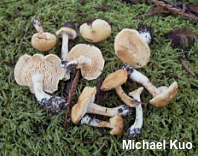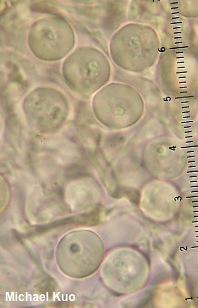| Major Groups > Toothed Mushrooms > Hydnum > Hydnum oregonense |

|
Hydnum oregonense [ Basidiomycota > Cantharellales > Hydnaceae > Hydnum ... ] by Michael Kuo I'm sorry about the lousy photograph. I collected Hydnum oregonense 17 years ago, and I was in a big hurry. It was my first time in the coastal woodlands of northern California, mushrooms were everywhere, and I had already used up my non-mushrooming friend's MPA (Mushroom Patience Allowance). The photo is just barely sufficient to show the salient features of Hydnum oregonense: the relatively small size and slender stature, the tendency of the cap to develop a small "navel" in the center, and the pale orange color. Although measuring spores is probably not needed for casual identification purposes, the spores of Hydnum oregonense are round and distinctively large. Western North American authors have treated Hydnum oregonense as "Hydnum umbilicatum," since it appears to match Peck's 1902 description of that species as having small stature and a "small but usually deep and distinct umbilicus." However, Peck's species was collected in the Adirondacks and has smaller spores (averaging 8.4 x 8.0 µm)—factors which led Norvell and collaborators (in Niskanen 2018) to describe Hydnum oregonense as a separate species. Description: Ecology: Mycorrhizal with conifers, including Douglas-fir, Bishop pine, and western hemlock; growing gregariously on the ground, often near stumps and decaying logs; winter and spring; distributed from northern California to Alaska. The illustrated and described collection is from California. Cap: 2–4 cm wide; broadly convex, becoming planoconvex and often developing a small central "navel"; dry; soft; dull, pale orange. Undersurface: Not running down the stem; covered with densely packed, soft spines that are round in cross-section and measure 1–4 mm long; whitish creamy with a hint of orangish; not bruising. Stem: 2–5 cm long; 0.5–1 cm thick; dry; bald; whitish; discoloring and staining orangish to brownish orange. Flesh: Whitish; slowly orangish when sliced; brittle. Odor and Taste: Not distinctive. Microscopic Features: Spores 8.5–10.5 µm; subglobose, with an apiculus; smooth; hyaline in KOH. Basidia 2- and 4-sterigmate; 30–35 x 8–10 µm; subclavate. Pseudocystidia 30–40 x 3–8 µm; mostly cylindric with rounded apices, but also lageniform; thin-walled; smooth; hyaline in KOH. Pileipellis not clearly differentiated; cap surface hyphae tangled, 2–4 µm wide, ochraceous to golden in KOH, with clamp connections. REFERENCES: Norvell, Liimatainen & Niskanen, 2018. (Schalkwijk-Barendsen, 1991; Trudell & Ammirati, 2009; Olariaga et al., 2012; Vizzini et al., 2013; Desjardin, Wood & Stevens, 2015; Feng et al., 2016; Siegel & Schwarz, 2016; Niskanen et al., 2018.) Herb. Kuo 02200307. This site contains no information about the edibility or toxicity of mushrooms. |
© MushroomExpert.Com |
|
Cite this page as: Kuo, M. (2020, September). Hydnum oregonense. Retrieved from the MushroomExpert.Com Web site: http://www.mushroomexpert.com/hydnum_oregonense.html |

